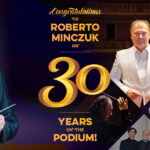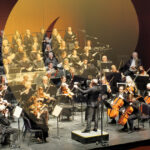Concert Review: Rachmaninoff Rhapsody / November 22, 2014
This review appeared in the 2014 Albuquerque Journal. Reprinted with kind permission.
by D.S. Crafts
Variation in the 20th century was the theme of Saturday’s New Mexico Philharmonic Classics concert at Popejoy Auditorium. Indeed, the three composers featured, Rachmaninoff, Hindemith and Sibelius all had very idiosyncratic methods of approaching music in variation. Guest conductor Oriol Sans led guest pianist Alexander Gavrylyuk in a stunning performance of the Rhapsody on a Theme of Paganini by Rachmaninoff, along with the Symphonic Metamorphosis of themes by Carl Maria von Weber by Hindemith, and finally the Symphony No. 2 of Sibelius.
I once heard the Hindemith work referred to as slight pieces by Weber tarted up. While Hindemith never had an overabundant sense of melody, he knew how to orchestrate and especially how to use the colors of the 20th century orchestra. So his beginning with extant melodies leads to an attractive showpiece. Sans directed the orchestra in a explosive splash of orchestral playing. Among the many highlights, an extensive and brilliant flute solo by Valerie Potter[cq] in the third movement. While the second movement Scherzo can be brutally repetitious in its “Chinese” theme, relief came in some jazzy, syncopation from the Philharmonic’s excellent brass section, which then gave way to a showcase of winds and percussion.
Last season Alexander Gavrylyuk astounded us with a performance of Rachmaninoff’s Third Piano Concerto. He returned Saturday with more Rachmaninoff and our memories of his amazing abilities were rekindled anew. No surprise to anyone after hearing him, Gavrylyuk has to his credit many international accolades including the grand prize of the Rubinstein International Piano Masters Competition.
Equal in stature to Rachmaninoff’s four piano concertos as regards virtuosity, the Rhapsody on a Theme of Paganini is perhaps the closest of the three works on the program to traditional variation form. The famous main theme is manipulated in myriad disguise always far more Rachmaninoff than Paganini. The beloved 18th variation was almost understated, rising in volume and intensity but never descending to saccharine cliché. Gavrylyuk’s sense of lyricism was matched by an immaculate technique.
As he did last year, the Ukranian pianist gave us as encore the Liszt/Horowitz adaptation of Mendelssohn’s Wedding March. Quite an amazing exhibition of piano mastery even exceeding the Rachmaninoff in pure dexterity, the notes rolling off his hands faster than the eye could catch. This was a performance not to be missed. If Gavrylyuk returns next year, make every effort to see him.
Sibelius’ method of composing was itself a study in variation, but not in the classical sense. Melodic fragments constantly transform themselves into ever new fragments ultimately (usually) culminating in a grand theme as happens in the Second Symphony. He is a composer who more than perhaps any other creates his own musical logic and momentum, often with a sense of otherworldly atmosphere. Sans masterly traversed the light and shadow of the work’s dark-timbred grandeur to produce a moving tapestry of opulent and highly original symphonic expression.
The concert began with a memorial tribute to Joan Dreyer Allen in the form of Bach’s Air from the Orchestral Suite No. 3.




